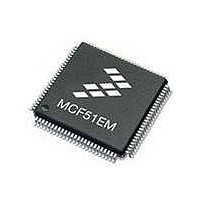MCF51EM256CLL Freescale Semiconductor, MCF51EM256CLL Datasheet - Page 615

MCF51EM256CLL
Manufacturer Part Number
MCF51EM256CLL
Description
IC MCU 32BIT 256KB FLASH 100LQFP
Manufacturer
Freescale Semiconductor
Series
MCF51EMr
Datasheets
1.MCF51EM128CLL.pdf
(2 pages)
2.MCF51EM128CLL.pdf
(54 pages)
3.MCF51EM128CLL.pdf
(636 pages)
Specifications of MCF51EM256CLL
Core Processor
Coldfire V1
Core Size
32-Bit
Speed
50MHz
Connectivity
I²C, SCI, SPI
Peripherals
LCD, LVD, PWM, WDT
Number Of I /o
63
Program Memory Size
256KB (256K x 8)
Program Memory Type
FLASH
Ram Size
16K x 8
Voltage - Supply (vcc/vdd)
1.8 V ~ 3.6 V
Data Converters
A/D 16x12b
Oscillator Type
External
Operating Temperature
-40°C ~ 85°C
Package / Case
100-LQFP
Processor Series
MCF51EM
Core
ColdFire V1
Data Bus Width
32 bit
Data Ram Size
16 KB
Interface Type
RS-232, LIN
Maximum Clock Frequency
50 MHz
Number Of Timers
3
Operating Supply Voltage
1.8 V to 3.6 V
Maximum Operating Temperature
+ 85 C
Mounting Style
SMD/SMT
3rd Party Development Tools
JLINK-CF-BDM26, EWCF
Development Tools By Supplier
DEMOEM
Minimum Operating Temperature
- 40 C
Lead Free Status / RoHS Status
Lead free / RoHS Compliant
Eeprom Size
-
Lead Free Status / Rohs Status
Lead free / RoHS Compliant
Available stocks
Company
Part Number
Manufacturer
Quantity
Price
Company:
Part Number:
MCF51EM256CLL
Manufacturer:
FREESCALE
Quantity:
110
Company:
Part Number:
MCF51EM256CLL
Manufacturer:
Freescale Semiconductor
Quantity:
10 000
- Current page: 615 of 636
- Download datasheet (11Mb)
26.4.1.5.25 BDM Accesses of the MAC Registers
The presence of rounding logic in the output datapath of the MAC requires special care for BDM-initiated
reads and writes of its programming model. In particular, any result rounding modes must be disabled
during the read/write process so the exact bit-wise MAC register contents are accessed.
For example, a BDM read of the accumulator (ACC) must be preceded by two commands accessing the
MAC status register, as shown in the following sequence:
BdmReadACC (
)
Likewise, to write an accumulator register, the following BDM sequence is needed:
BdmWriteACC (
)
For more information on saving and restoring the complete MAC programming model, see
Section 9.3.1.2, “Saving and Restoring the MAC Programming Model.”
26.4.1.6
BDC commands that require CPU execution are ultimately treated at the core clock rate. Because the BDC
clock source can be asynchronous relative to the bus frequency when CLKSW is cleared, it is necessary
to provide a handshake protocol so the host can determine when an issued command is executed by the
CPU. This section describes this protocol.
The hardware handshake protocol signals to the host controller when an issued command was successfully
executed by the target. This protocol is implemented by a low pulse (16 BDC clock cycles) followed by a
brief speedup pulse on the BKGD pin, generated by the target MCU when a command, issued by the host,
has been successfully executed. See
ACK pulse is finished, the host can start the data-read portion of the command if the last-issued command
was a read command, or start a new command if the last command was a write command or a control
command (BACKGROUND, GO, NOP, SYNC_PC). The ACK pulse is not issued earlier than 32 BDC
clock cycles after the BDC command was issued. The end of the BDC command is assumed to be the 16th
BDC clock cycle of the last bit. This minimum delay assures enough time for the host to recognize the
ACK pulse. There is no upper limit for the delay between the command and the related ACK pulse,
because the command execution depends on the CPU bus frequency, which in some cases could be slow
compared to the serial communication rate. This protocol allows great flexibility for pod designers,
because it does not rely on any accurate time measurement or short response time to any event in the serial
communication.
Freescale Semiconductor
rcreg
wcreg
rcreg
wcreg
rcreg
wcreg
wcreg
wcreg
Serial Interface Hardware Handshake Protocol
MCF51EM256 Series ColdFire Integrated Microcontroller Reference Manual, Rev. 8
macsr;
#0,macsr;
ACC;
#saved_data,macsr;// restore the original macsr
macsr;
#0,macsr;
#data,ACC;
#saved_data,macsr;// restore the original macsr
Figure
// read current macsr contents and save
// disable all rounding modes
// read the desired accumulator
// read current macsr contents and save
// disable all rounding modes
// write the desired accumulator
26-20. This pulse is referred to as the ACK pulse. After the
Version 1 ColdFire Debug (CF1_DEBUG)
26-51
Related parts for MCF51EM256CLL
Image
Part Number
Description
Manufacturer
Datasheet
Request
R

Part Number:
Description:
BOARD DEMO HARDWARE ONLY
Manufacturer:
Freescale Semiconductor
Datasheet:

Part Number:
Description:
IC MCU 32BIT 128KB FLASH 100LQFP
Manufacturer:
Freescale Semiconductor
Datasheet:

Part Number:
Description:
IC MCU 32BIT 128KB FLASH 80LQFP
Manufacturer:
Freescale Semiconductor
Datasheet:

Part Number:
Description:
IC MCU 32BIT 256KB FLASH 80LQFP
Manufacturer:
Freescale Semiconductor
Datasheet:
Part Number:
Description:
Manufacturer:
Freescale Semiconductor, Inc
Datasheet:
Part Number:
Description:
Manufacturer:
Freescale Semiconductor, Inc
Datasheet:
Part Number:
Description:
Manufacturer:
Freescale Semiconductor, Inc
Datasheet:
Part Number:
Description:
Manufacturer:
Freescale Semiconductor, Inc
Datasheet:
Part Number:
Description:
Manufacturer:
Freescale Semiconductor, Inc
Datasheet:
Part Number:
Description:
Manufacturer:
Freescale Semiconductor, Inc
Datasheet:
Part Number:
Description:
Manufacturer:
Freescale Semiconductor, Inc
Datasheet:
Part Number:
Description:
Manufacturer:
Freescale Semiconductor, Inc
Datasheet:
Part Number:
Description:
Manufacturer:
Freescale Semiconductor, Inc
Datasheet:
Part Number:
Description:
Manufacturer:
Freescale Semiconductor, Inc
Datasheet:











